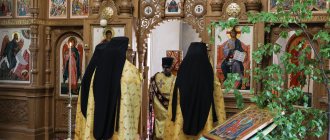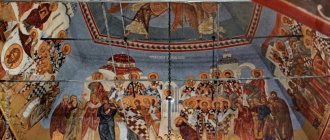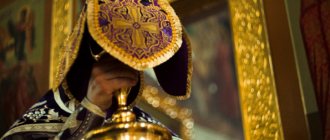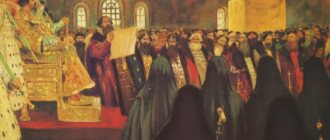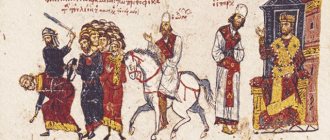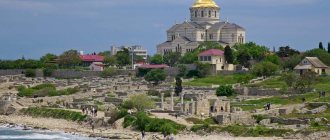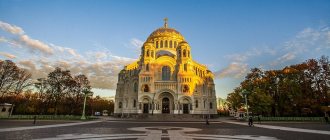| Second Ecumenical Council. Fresco from the 16th century, Sucevita Monastery, Romania. |
The Second Ecumenical Council
was convened in 381 in Constantinople under the holy emperor Theodosius the Great Memory May 22
- On the map: Yandex.Map, Google map (no exact coordinates)
The Council was convened against the false teaching of the former Arian bishop of Constantinople, Macedonius, who rejected the Divinity of the third Person of the Holy Trinity, the Holy Spirit. He taught that the Holy Spirit is not God, and called Him a creature or created force and, moreover, serving God the Father and God the Son, similar to Angels.
150 bishops were present at the Council.
The confession of faith approved at the Roman Council was proposed for the consideration of the holy fathers, which Saint Pope Damasus sent to Bishop Paulinus of Antioch. Having read the scroll, the holy fathers, rejecting the false teaching of Macedonius, unanimously affirmed the apostolic teaching that the Holy Spirit is not a service being, but the Life-Giving Lord, proceeding from the Father, worshiped and glorified with the Father and the Son. To refute other heresies - Eunomians, Arians and Semi-Arians - the holy fathers confirmed the Nicene Creed.
The Symbol adopted by the First Ecumenical Council did not speak of the Divine dignity of the Holy Spirit, for there was no Doukhobor heresy at that time. Therefore, the holy fathers of the Second Ecumenical Council added 8, 9, 10, 11 and 12 members to the Nicene Symbol, i.e., they finally formulated and approved the Nicene-Constantinopolitan Symbol, which is still professed by the entire Orthodox Church.
The Second Ecumenical Council, in addition, established the forms of church court, determined to accept into communion through the Sacrament of Confirmation repentant heretics who were baptized in the Name of the Holy Trinity, and to accept those baptized by single immersion as pagans.
Saint Gregory the Theologian, Patriarch of Constantinople, in his speech at the Council gave the following statement of the Orthodox faith:
“The Beginningless Beginning and the Existing One with the Beginning are One God. But beginninglessness or unbornness is not the nature of the Beginningless One. For every nature is determined not by what it is not, but by what it is: it is a position, and not a negation of what exists. And the Beginning, in that it is the beginning is not separated from the Beginningless, for for Him to be the beginning does not constitute nature, just as for the first to be beginningless; because this only relates to nature, and is not nature itself. And the Existing One with the Beginning and the Beginning is nothing other than the same as They. The Name of the Beginningless is the Father, the Beginning is the Son, the Existing One with the Beginning is the Holy Spirit; and the nature in the Three is one - God. Unity is the Father, from Whom and to Whom they are raised, not merging, but co-abiding with Him, and not separated from each other by time, desire, or power.”
Participants
Gregory the Theologian
150 Orthodox bishops were present at the Council. Theodosius also invited 36 Macedonian bishops to the Council, led by the eldest bishop Eleusius of Cyzicus, hoping that they would agree in their confession of faith with the orthodox. But the bishops of Macedonia and Egypt directly stated that they do not and will not allow “consistency”, and left the Council. Emperor Theodosius did not even notify Pope Damasius (from the Western Roman Empire of Gratian) about the opening of the Council.
Among the main participants of the Council were: Meletius of Antioch, Timothy I of Alexandria, Cyril of Jerusalem, Gelasius of Caesarea-Palestine (nephew of Cyril), Ascholius of Thessaloniki, Gregory of Nyssa (brother of Basil the Great), Amphilochius of Iconium, Optimus of Antioch of Pisidia, Diodorus of Tarsus, Pelagius of Laodicea. The Council was presided over by Meletius of Antioch, who died shortly after the Council began, and was replaced by Gregory of Nazianzus (c.330-c.390), known in the church under the name of the Theologian, and after he left the Council - Nektarios, Gregory's successor at the See of Constantinople.
Content
- 1 Participants
- 2 Council resolutions 2.1 About Maximus the Cynic (4th rule)
- 2.2 About heresies (1st rule)
- 2.3 About the Nicene-Constantinopolitan Creed (5th rule)
- 2.4 On the status of the Bishop of Constantinople (3rd rule)
- 2.5 On the autocephalous governance of local Churches (2nd rule)
- 2.6 About complaints of a private and church nature (6th rule)
- 2.7 On the form of church court and the acceptance of heretics into church communion (7th rule)
